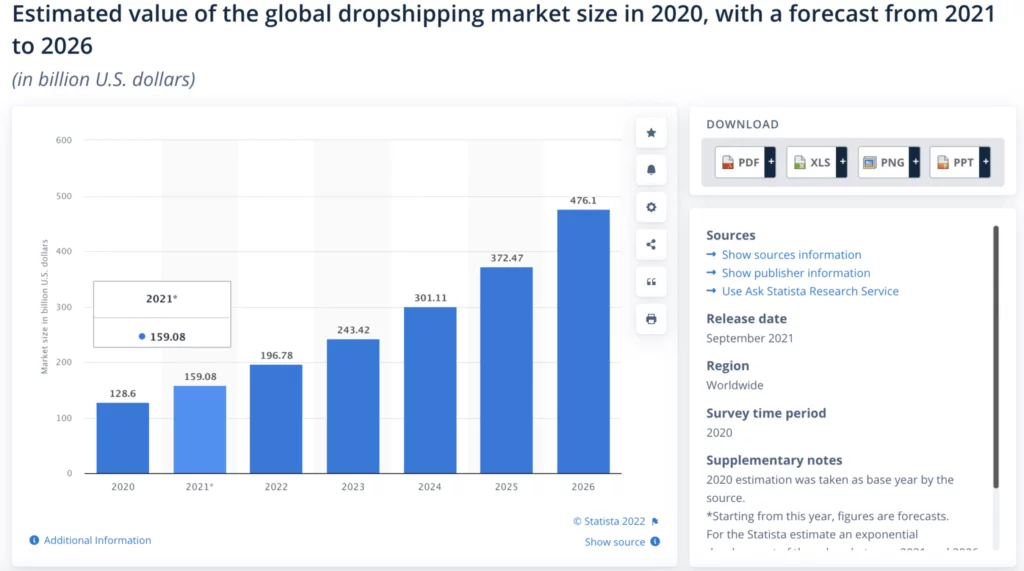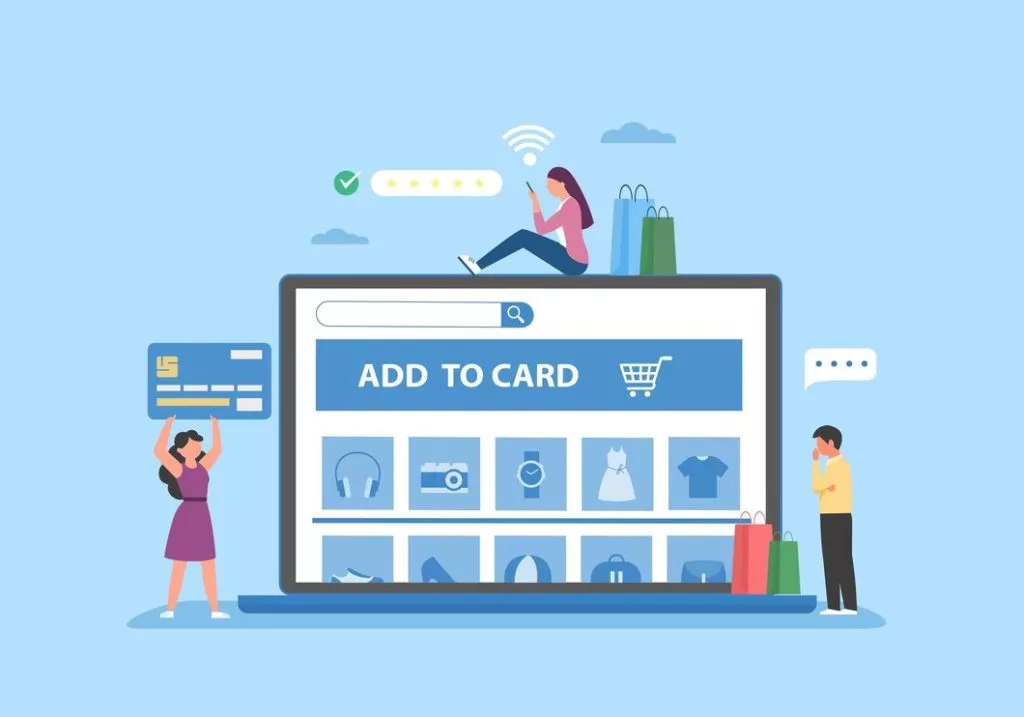High-ticket drop shipping presents entrepreneurs with both enticing opportunities and potential pitfalls. Before diving in, it’s crucial to understand the intricacies of this business model, conduct thorough research, and equip yourself with the necessary knowledge and strategies for success.
E-commerce has been experiencing significant growth globally. According to Statista, global e-commerce sales amounted to $4.28 trillion in 2020 and are projected to surpass $6.3 trillion by 2024.
What is High-Ticket Dropshipping?

High-ticket dropshipping involves selling expensive items online while utilizing the dropshipping model. Rather than holding inventory, entrepreneurs partner with suppliers who directly ship products to customers upon purchase.
Characteristics of High-Ticket Items:
- Higher Profit Margins: While sales volumes may be lower, each transaction yields substantial profits due to the premium price of items, typically ranging from $200 to $5,000.
- Non-Impulse Purchases: Customers meticulously research and deliberate before investing in high-ticket items, which are often considered significant purchases requiring careful consideration.
- Emphasis on Quality: Given the premium price point, customers expect superior quality products. Therefore, sourcing from reputable suppliers is essential to maintain customer satisfaction and brand integrity.
Learn more about dropshipping here.
Benefits of High-Ticket Dropshipping:
High-ticket dropshipping offers several compelling benefits for entrepreneurs looking to enter the e-commerce market:
- High Profit Margins: Selling expensive items means each sale generates a significant profit. While sales volumes may be lower compared to low-ticket items, the profit margin per sale is typically much higher, resulting in lucrative returns.
- Lower Sales Volume Requirements: With high-profit margins, entrepreneurs don’t need to rely on high sales volumes to achieve profitability. Selling fewer items can still yield substantial income, making it an appealing option for those looking to streamline their operations.
- Reduced Inventory Management: High-ticket dropshipping eliminates the need to hold inventory, reducing overhead costs associated with warehousing, storage, and inventory management. This lowers the barrier to entry for entrepreneurs and allows for a more agile and cost-effective business model.
- Targeting Affluent Audiences: Selling premium, high-quality products appeals to affluent consumers who are willing to invest in luxury items. By catering to this niche market segment, entrepreneurs can tap into higher purchasing power and capture a lucrative customer base.
- Minimal Upfront Investment: Unlike traditional retail models that require substantial capital investment in inventory, high-ticket dropshipping allows entrepreneurs to start with minimal upfront costs. This makes it accessible to individuals with limited capital or those looking to test the market before scaling their operations.
- Scalability and Flexibility: High-ticket dropshipping offers scalability without the constraints of inventory management. Entrepreneurs can easily expand their product offerings, enter new markets, or adjust their business model to adapt to changing consumer preferences and market trends.
- Focus on Marketing and Customer Experience: With fewer operational concerns related to inventory management, entrepreneurs can focus their resources and efforts on marketing, branding, and delivering exceptional customer experiences. This enables them to differentiate their brand, build customer loyalty, and drive long-term success.
- Diversification and Risk Management: By offering a range of high-ticket products across different categories or niches, entrepreneurs can diversify their revenue streams and mitigate the risk associated with relying on a single product or market segment.
Strategies for High Ticket Dropshipping:
Step 1: Market Research

Embarking on the journey of high-ticket dropshipping demands a solid understanding of the competitive landscape and consumer demands. This crucial step ensures that you enter the market well-prepared and equipped with valuable insights to guide your business decisions effectively.
Begin by delving into comprehensive market research to gain clarity on your niche, target audience, and market dynamics.
- Analyze Market Trends: Utilize tools like Google Trends to track industry trends and identify emerging opportunities. Assess fluctuations in consumer interest and pinpoint areas of high demand within your chosen niche.
- Study Competitors: Identify key players within your niche and analyze their product offerings, pricing strategies, and marketing tactics. Gain insights into successful approaches and potential gaps in the market which you can exploit to differentiate your brand.
- Conduct Keyword Research: Dive into keyword research to understand the language and search queries used by your target audience. Leverage tools such as Google Keyword Planner or Ahrefs to uncover relevant keywords and assess search volume and competition levels.
- Perform SWOT Analysis: Conduct a SWOT analysis to evaluate the strengths, weaknesses, opportunities, and threats in your chosen niche. Identify areas where you can leverage the strengths, address weaknesses, capitalize on opportunities, or mitigate potential threats.
Step 2: Find Reliable Dropshipping Suppliers

Selecting the right dropshipping supplier is paramount to the success of your high-ticket dropshipping venture. Your supplier serves as the foundation of your business, influencing the quality, reliability, and efficiency of your operations.
Here’s how to find reputable dropshipping suppliers and vet them effectively:
- Research Supplier Options: Explore various dropshipping suppliers specializing in high-ticket items. Utilize online directories, industry forums, and trade shows to identify potential partners.
- Ask Key Questions: Reach out to prospective suppliers and inquire about their offerings and policies. Ask pertinent questions such as:
- What product range do you offer for dropshipping?
- Are your products genuine and of high quality?
- How frequently do you update your product catalog?
- Do you impose a Minimum Order Quantity (MOQ)?
- What are your pricing structures and payment terms?
- What is your shipping policy, including delivery times and costs?
- Do you provide tracking information for shipments?
- How do you handle returns and refunds?
- Which eCommerce platforms do you integrate with?
- How can I contact the customer support team for assistance?
- Assess Reliability and Support: Evaluate the responsiveness and professionalism of the supplier’s customer support team. Ensure they offer efficient communication channels and timely assistance.
- Seek References and Reviews: Request references or seek out reviews from other dropshippers who have partnered with the supplier. Assess their experiences to gauge reliability and customer satisfaction.
Step 3: Establish Your eCommerce Presence

Creating a robust eCommerce store is crucial to showcasing your high-ticket dropshipping products and attracting potential customers. Follow these steps to build your online storefront effectively:
- Choose the Right Platform: Select an eCommerce platform which aligns with your business goals and technical requirements. Popular options include Shopify, WooCommerce, BigCommerce, Wix, and Shift4Shop. Assess each platform’s features, pricing, and customization options before making a decision.
- Design Your Website: Craft a visually appealing and user-friendly website design which reflects your brand identity. Choose a clean layout, intuitive navigation, and high-quality imagery to enhance the user experience. Ensure that the website is mobile-responsive to cater to users on all devices.
- Optimize for Conversions: Implement conversion optimization strategies to maximize sales and revenue. Utilize persuasive product descriptions, compelling calls-to-action, and streamlined checkout processes to encourage visitors to make purchases. Besides, integrate customer reviews and testimonials to build trust and credibility.
- Explore Platform-Specific Guides: Take advantage of comprehensive guides and tutorials provided by eCommerce platforms to familiarize yourself with their features and functionalities. Learn to set up your store, add products, configure payment gateways, and optimize for search engines. Some recommended resources include:
- “The Ultimate Shopify Dropshipping Guide”
- “The Ultimate Guide to Dropshipping with WooCommerce”
- “Dropshipping with Wix: Everything You Need to Know”
- “Beginner’s Guide to Shift4Shop Dropshipping”
Step 4: Promoting Your High-Ticket Dropshipping Store: Effective Strategies to Stand Out

In today’s digital landscape, there are numerous avenues to elevate your dropshipping store’s visibility and distinguish it from the competition. Here are several proven strategies to kickstart your promotional efforts:
Social Media Advertising:
- Facebook Advertising: Leverage the robust advertising capabilities of Facebook to expand your brand’s reach and drive sales. With diverse marketing objectives, such as traffic, engagement, and lead generation, Facebook enables you to craft targeted ads tailored to your audience’s preferences. Create compelling Facebook ads showcasing specific high-ticket products to entice potential customers.
- Instagram Advertising: Harness the power of visual storytelling on Instagram to showcase your branded products and captivate your audience. Explore two main advertising options: collaborating with influencers to promote your dropshipping store or utilizing Instagram ads to target specific demographics and regions. Tailor your ad content to resonate with your target audience and highlight the unique value propositions of your high-ticket items.
- TikTok Advertising: Capitalize on the burgeoning popularity of TikTok advertising to engage with a diverse demographic of potential customers. Contrary to common misconceptions, TikTok boasts a substantial user base spanning various age groups, with a significant percentage falling within the 19-29 age bracket—ideal for targeting dropshipping and online shopping enthusiasts. Craft compelling ad content that aligns with TikTok’s dynamic and creative culture to capture audience attention and drive conversions.
Step 5: Product Reviews

After successfully completing sales, kindly request feedback from satisfied customers about their shopping experience. Genuine reviews and testimonials from previous buyers serve as powerful indicators of the reliability and authenticity of your products. Sharing these testimonials with potential customers enhances your store’s credibility and online visibility, expanding your customer base.
SEO:
Optimizing your eCommerce store for search engines may seem daunting, but employing effective techniques can significantly boost your website’s domain rating and search engine results page (SERP) rankings. In addition to utilizing ads and showcasing product reviews, prioritize enhancing your store’s visibility in SERPs through various strategies:
- Enhance meta titles and descriptions for product pages to improve search engine visibility.
- Establish a blog section to disseminate valuable content that resonates with your target audience.
- Optimize keyword density within your website content to align with relevant search queries.
- Develop a comprehensive sitemap for your website to facilitate search engine crawling and indexing.
- Implement a simple and intuitive website structure to enhance user experience and navigation.
- Incorporate high-quality product images to provide users with a visually engaging shopping experience.
Conclusion:
Embarking on the journey of high-ticket dropshipping presents a promising opportunity to establish a lucrative online business. By meticulously planning your approach, selecting a profitable niche, and understanding your target audience, you lay the foundation for a thriving venture. With the comprehensive guidance provided in this guide, you are equipped with the knowledge and strategies to successfully navigate the complexities of high-ticket dropshipping. Now, it’s your turn to take action, implement the insights gained, and embark on the path toward building a prosperous online store.
FAQs on High-Ticket Dropshipping:
How can I attract customers to my high-ticket dropshipping store?
- Use social media advertising platforms such as Facebook, Instagram, and TikTok.
- Encourage satisfied customers to write reviews and testimonials to build credibility.
- Optimize your website for search engines with the help of SEO techniques.
- Offer exceptional customer service and provide valuable content to engage potential customers.
What are the potential challenges of high-ticket drop shipping?
- Higher upfront costs associated with acquiring inventory and marketing.
- Finding reliable suppliers capable of fulfilling orders for high-value products.
- Managing customer expectations regarding product quality, shipping times, and returns.
- Navigating competition in the market and staying updated with industry trends.



